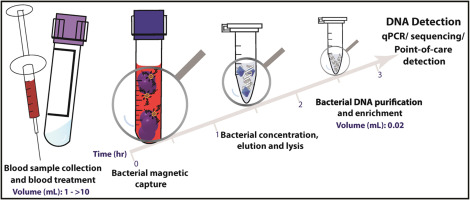Biosensors and Bioelectronics ( IF 10.7 ) Pub Date : 2017-07-24 , DOI: 10.1016/j.bios.2017.07.057 Marwa M. Hassan , Andrea Ranzoni , Matthew A. Cooper

|
Point-of-care (POC) diagnostics are one of the quick and sensitive detection approaches used in current clinical applications, but always face a performance tradeoff between time-to-result and assay sensitivity. One critical setting where these limitations are evident is the detection of sepsis, where 6–10 mL of whole blood may contain as little as one bacterial colony forming unit (cfu). The large sample volume, complex nature of the sample and low analyte concentration necessitates signal enhancement using culture-based or molecular amplification techniques. In the time-critical diagnosis of sepsis, waiting for up to 24 h to produce sufficient DNA for analysis is not possible. As a consequence, there is a need for integrated sample preparation methods that could enable shorter detection times, whilst maintaining high analytical performance. We report the development of a culture-free bacterial enrichment method to concentrate bacteria from whole blood in less than 3 h. The method relies on triple-enrichment steps to magnetically concentrate bacterial cells and their DNA with a 500-fold reduction in sample volume (from 10 to 0.02 mL). Using this sample preparation method, sensitive qPCR detection of the extracted S. aureus bacterial DNA was achieved with a detection limit of 5±0.58 cfu/mL within a total elapsed time of 4 h; much faster than conventional culture-based approaches. The method could be fully automated for integration into clinical practice for point-of-care or molecular detection of bacterial DNA from whole blood.
中文翻译:

一种基于纳米粒子的全血无细菌DNA富集方法
即时诊断(POC)诊断是当前临床应用中使用的快速灵敏的检测方法之一,但是始终要在结果时间与检测灵敏度之间进行性能折衷。这些限制显而易见的一个关键条件是败血症的检测,其中6-10 mL的全血可能只含有一个细菌菌落形成单位(cfu)。样品量大,样品性质复杂且分析物浓度低,因此需要使用基于培养物或分子扩增技术的信号增强。在对脓毒症有时间紧迫的诊断中,要等待长达24小时才能产生足够的DNA进行分析是不可能的。结果,需要集成的样品制备方法,该方法可以缩短检测时间,同时保持较高的分析性能。我们报告了无文化细菌富集方法的发展,以在不到3小时的时间内浓缩全血中的细菌。该方法依靠三重富集步骤来磁性浓缩细菌细胞及其DNA,样品体积减少了500倍(从10毫升减少到0.02毫升)。使用这种样品制备方法,可以对提取物进行灵敏的qPCR检测在总经过4 h的时间内,金黄色葡萄球菌细菌DNA的检出限为5±0.58 cfu / mL。比传统的基于文化的方法要快得多。该方法可以完全自动化,以整合到临床实践中,以进行现场护理或全血细菌DNA的分子检测。

































 京公网安备 11010802027423号
京公网安备 11010802027423号